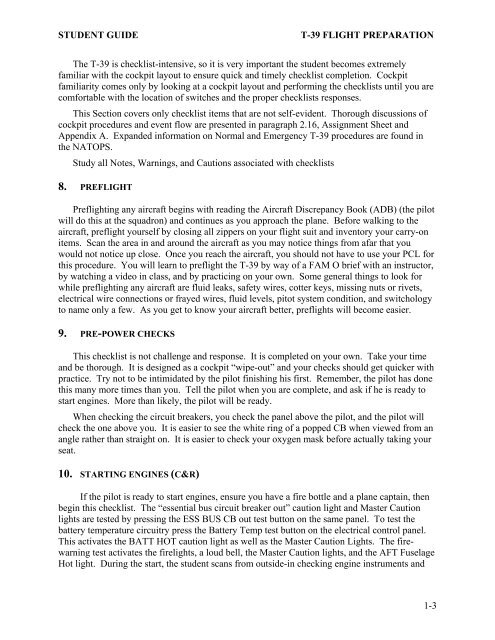t-39 - Chief of Naval Air Training
t-39 - Chief of Naval Air Training
t-39 - Chief of Naval Air Training
You also want an ePaper? Increase the reach of your titles
YUMPU automatically turns print PDFs into web optimized ePapers that Google loves.
STUDENT GUIDE T-<strong>39</strong> FLIGHT PREPARATION<br />
The T-<strong>39</strong> is checklist-intensive, so it is very important the student becomes extremely<br />
familiar with the cockpit layout to ensure quick and timely checklist completion. Cockpit<br />
familiarity comes only by looking at a cockpit layout and performing the checklists until you are<br />
comfortable with the location <strong>of</strong> switches and the proper checklists responses.<br />
This Section covers only checklist items that are not self-evident. Thorough discussions <strong>of</strong><br />
cockpit procedures and event flow are presented in paragraph 2.16, Assignment Sheet and<br />
Appendix A. Expanded information on Normal and Emergency T-<strong>39</strong> procedures are found in<br />
the NATOPS.<br />
Study all Notes, Warnings, and Cautions associated with checklists<br />
8. PREFLIGHT<br />
Preflighting any aircraft begins with reading the <strong>Air</strong>craft Discrepancy Book (ADB) (the pilot<br />
will do this at the squadron) and continues as you approach the plane. Before walking to the<br />
aircraft, preflight yourself by closing all zippers on your flight suit and inventory your carry-on<br />
items. Scan the area in and around the aircraft as you may notice things from afar that you<br />
would not notice up close. Once you reach the aircraft, you should not have to use your PCL for<br />
this procedure. You will learn to preflight the T-<strong>39</strong> by way <strong>of</strong> a FAM O brief with an instructor,<br />
by watching a video in class, and by practicing on your own. Some general things to look for<br />
while preflighting any aircraft are fluid leaks, safety wires, cotter keys, missing nuts or rivets,<br />
electrical wire connections or frayed wires, fluid levels, pitot system condition, and switchology<br />
to name only a few. As you get to know your aircraft better, preflights will become easier.<br />
9. PRE-POWER CHECKS<br />
This checklist is not challenge and response. It is completed on your own. Take your time<br />
and be thorough. It is designed as a cockpit “wipe-out” and your checks should get quicker with<br />
practice. Try not to be intimidated by the pilot finishing his first. Remember, the pilot has done<br />
this many more times than you. Tell the pilot when you are complete, and ask if he is ready to<br />
start engines. More than likely, the pilot will be ready.<br />
When checking the circuit breakers, you check the panel above the pilot, and the pilot will<br />
check the one above you. It is easier to see the white ring <strong>of</strong> a popped CB when viewed from an<br />
angle rather than straight on. It is easier to check your oxygen mask before actually taking your<br />
seat.<br />
10. STARTING ENGINES (C&R)<br />
If the pilot is ready to start engines, ensure you have a fire bottle and a plane captain, then<br />
begin this checklist. The “essential bus circuit breaker out” caution light and Master Caution<br />
lights are tested by pressing the ESS BUS CB out test button on the same panel. To test the<br />
battery temperature circuitry press the Battery Temp test button on the electrical control panel.<br />
This activates the BATT HOT caution light as well as the Master Caution Lights. The firewarning<br />
test activates the firelights, a loud bell, the Master Caution lights, and the AFT Fuselage<br />
Hot light. During the start, the student scans from outside-in checking engine instruments and<br />
1-3
















